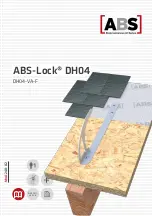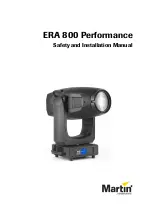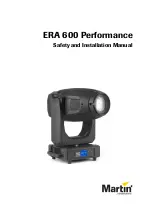
Safety Precautions and Warnings
MicroHarmony Cell Sizes 40 - 260A Manual
vi
19001467: Version 1.0
s
Warning!
•
Always
comply with local codes and requirements if disposal of failed components is
necessary (for example, CPU battery, capacitors, etc.).
•
Always
ensure the use of an even and flat truck bed to transport the WCIII drive system. Before
unloading, be sure that the concrete pad is level for storage and permanent positioning.
•
Always
confirm proper tonnage ratings of cranes, cables, and hooks when lifting the
drive system. Dropping the cabinet or lowering it too quickly could damage the unit.
•
Never
disconnect control power while medium voltage is energized. This could cause
severe system overheating and/or damage.
•
Never
store flammable material in, on, or near the cell. This includes equipment drawings and manuals.
•
Never
use fork trucks to lift cabinets that are not equipped with lifting tubes. Be sure
that the fork truck tines fit the lifting tubes properly and are the appropriate length.
•
Never
run the cell with the chassis lid off or cell control board panel removed unless open area is prop-
erly covered and sealed off. This ensures personal safety and proper air flow.
•
Do not
energize the cell without air flow. Although the cell may not be loaded, the bleeder resistor will
dissipate heat during no load. This will stress the resistor and possible melt wires. Always have ade-
quate air flow before energizing.
•
Always
use the recommended fuses. Fuses were specifically selected to coordinate all known types of
faults, overloads, and inrush current. Improper fuse selection can cause nuisance trips or high imped-
ance arcing faults that do not clear which could result in a catastrophic fire.
•
When lifting with cranes, be sure the crane, cables, and hooks have proper tonnage rating. Be careful
not to drop the cabinet or lower it too quickly. This could damage the unit.
•
When transporting the drive system, the truck bed must be even and flat. Before unloading, be sure that
the concrete pad is level for storage as well as permanent positioning.
ESD Sensitive Equipment!
•
IGBT gate emitter leads should be shorted when not installed in the cell or for transportation. Avoid
exposure to corrosive gases and dust.
•
Always be aware of electrostatic discharge (ESD) when working near or touching components inside
the MicroHarmony cell. The cell contains components that are sensitive to static electricity. Handling
and servicing of components that are sensitive to ESD should be done only by qualified personnel
and only after reading and understanding proper ESD techniques. The following ESD guidelines
should be followed. Following these rules can greatly reduce the possibility of ESD damage to PC
board components.
•
Always transport static sensitive equipment in antistatic bags.
•
Always use a soldering iron that has a grounded tip. Also, use either a metallic vacuum-style plunger
or copper braid when desoldering.
•
Make certain that anyone handling the printed circuit boards is wearing a properly grounded static
strap. The wrist strap should be connected to ground through a 1 megohm resistor. Grounding kits are
available commercially through most electronic wholesalers.
•
Static charge buildup can be removed from a conductive object by touching the object to a properly
grounded piece of metal.
•
When handling a PC board, always hold the card by its edges.
•
Do not slide printed circuit boards across any surface (e.g., a table or work bench). If possible, per-
form PCB maintenance at a workstation that has a conductive covering that is grounded through a 1
megohm resistor. If a conductive tabletop cover is unavailable, a clean steel or aluminum tabletop is
an excellent substitute.
•
Avoid plastic, Styrofoam
™
, vinyl and other non-conductive materials. They are excellent static gen-
erators and do not give up their charge easily.
•
When returning components to Siemens LD A, always use static-safe packing. This limits any further
component damage due to ESD.
Summary of Contents for Eupec
Page 16: ...Cell Overview MicroHarmony Cell Sizes 40 260A Manual 1 6 19001467 Version 1 0 s 1 ...
Page 36: ...Installation MicroHarmony Cell Sizes 40 260A Manual 3 4 19001467 Version 1 0 s 3 ...
Page 42: ...Electrical Description MicroHarmony Cell Sizes 40 260A Manual 4 6 19001467 Version 1 0 s 4 ...
Page 56: ...Repair Hints MicroHarmony Cell Sizes 40 260A Manual 8 4 19001467 Version 1 0 s 8 ...
Page 76: ...Drive Calc Express MicroHarmony Cell Sizes 40 260A Manual 10 2 19001467 Version 1 0 s 10 ...
Page 86: ...Communication Protocol MicroHarmony Cell Sizes 40 260A Manual 11 10 19001467 Version 1 0 s 11 ...
Page 87: ...MicroHarmony Cell Sizes 40 260A Manual NOTES 19001467 Version 1 0 N 1 s NOTES ...
Page 88: ...NOTES MicroHarmony Cell Sizes 40 260A Manual N 2 19001467 Version 1 0 s ...
Page 89: ...MicroHarmony Cell Sizes 40 260A Manual NOTES 19001467 Version 1 0 N 3 s ...
Page 90: ...NOTES MicroHarmony Cell Sizes 40 260A Manual N 4 19001467 Version 1 0 s ...









































